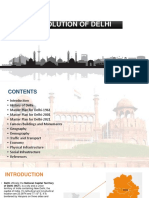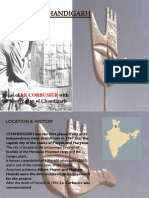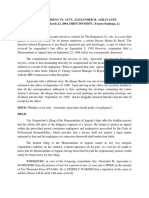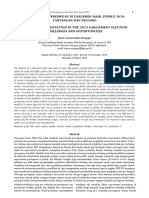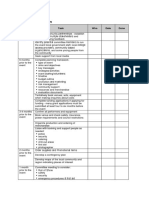State Profile State
State Profile State
Uploaded by
Mukesh NagarCopyright:
Available Formats
State Profile State
State Profile State
Uploaded by
Mukesh NagarOriginal Description:
Original Title
Copyright
Available Formats
Share this document
Did you find this document useful?
Is this content inappropriate?
Copyright:
Available Formats
State Profile State
State Profile State
Uploaded by
Mukesh NagarCopyright:
Available Formats
Draft- State Profile
Chapter II
NATIONAL CAPITAL TERRITORY - DELHI
2.1 General Characteristics Delhi is located in northern India between the latitudes of 28-24-17 and 28-53-00 North and longitudes of 76-50-24 and 77-20-37 East. Delhi shares bordering with the States of Uttar Pradeshand Haryana. Delhi widthis 48.48 kms. Delhi is situated on the right bank of the river Yamuna at the periphery of the Gangetic plains. It lies a little north of 28 n latitude and a little to the west of 78 longitude. To the west and south-west is the great Indian Thar desert of Rajasthan state, formerly known as Rajputana and, to the east lies the river Yamuna across which has spread the greater Delhi of today. The ridges of the Aravelli range extend right into Delhi proper, towards the western side of the city, and this has given an undulating character to some parts of Delhi. The meandering course of the river Yamuna meets the ridge of Wazirabad to the north; while to the south, the ridge branches off from Mehrauli. The main city is situated on the west bank of the river. 2.2 Physical Features 2.2.1 Geography Delhi is bounded by the Indo-Gangetic alluvial plains in the North and East, by Thar desert in the West and by Aravalli hill ranges in the South. The terrain of Delhi is flat in general except for a low Draft State Disaster Management Plan
Figure 1: Soil Characteristics of Delhi
BASIC STATISTICS ABOUT DELHI
Area: 1,483 sq.Km Number of districts: 9 Number of Urban villages: Per Capita income: Rs. 38,864
(As per Census2000-01)
has an area of 1,483 sq. kms. Its maximum length is 51.90 kms and greatest
Draft- State Profile
NNE-SSW trending ridge that is considered and extension of the Aravalli hills of Rajasthan. The ridge may be said to enter Delhi from the SW. The eastern part of the ridge extends up to Okhla in the South and disappears below Yamuna alluvium in the NE on the right bank of the river. 2.2.2. Hydrology In 90% of the land in Delhi fresh water is available up to 60 m depth and the quality of water is also all right i.e. in drinkable condition. Only some 10 % of the area comprises the ridge and some has saline and brackish waters.
Fresh Water at all levels (Alluvium and Quartzite) Fresh Water at all levels Upto 30 m depth (Alluvium) Fresh Water at all levels 30 60 m depth (Alluvium) Brackish/Saline water at all levels (Alluvium)
Figure 2: Water table in Delhi
Ridge
Water Quality becoming bad Water Quality is all right (for now) Source: Central Groundwater Board and Central Pollution Control Board
Draft State Disaster Management Plan
Draft- State Profile
Figure 3: Ground water Quality map of Delhi
Draft State Disaster Management Plan
Draft- State Profile
2.2.3 Physiography The river Yamuna, the Aravalli range, and the plains in between both of these from alluvium deposits of recent formation dominate the physiography of Delhi. The Delhi Ridge and its four sections, the northern, the central, the south central and the southern constitute the farthest extension of the Aravalli range, its spurs meeting the Yamuna at two points, in the north and the east. Ecologically, the Ridge acts a barrier between the Thar desert and the plains and slows down the movement of dust and wind from the desert. This green belt, a natural forest, has a moderating influence on temperature, besides bestowing other known benefits on the people The Yamuna river and terminal part of the Aravali hill range are the two main geographical features of the city. The Aravali hill range is covered with forest and is called the Ridges; they are the citys lungs and help maintain its environment. The Yamuna river is Delhis source of drinking water and a sacred river for most of the inhabitants. The Yamuna river originates from the Yamnotri glacier in the lower Himalayas at an elevation of about 6387 mtr. above mean sea level. From Tajewala, the river sluggishly meanders via Delhi to its confluence with the Ganga at Allahabad after flowing a distance of about 1200 kms. The total length of the river from origin to the confluence point at Allahabad is 1376 kms. The catchments of the Yamuna river system cover parts of Uttranchal, Uttar Pradesh, Himachal Pradesh, Haryana, Rajasthan, Delhi and Madhya Pradesh. 2.3 Administrative Setup 2.3.1 Under the British The British began their rule in Delhi in 1805 with the operation of General Regulations made by the British under the charge of the Resident and Chief Commissioner of Delhi. The system continued with periodic modifications till 1857. In 1858, the British made Delhi a provincial town of the Frontier Province
Draft State Disaster Management Plan
Draft- State Profile
and later transferred it to the newly formed Punjab province under a Lieutenant Governor. Delhi continued to be administered directly by the Government of India through a Chief Commissioner till 1950. With the shifting of the capital from Calcutta to Delhi, a separate Committee known as Imperial. Delhi Committee was formed on 25 March 1913 to oversee construction and management of the civic affairs of the new capital. In 1916, it was notified as the Raisina Municipal Committee under the Punjab Municipal Act 1911 primarily for meeting the sanitary needs of the workers engaged in the construction of the capital. Delhi district had a Deputy Commissioner who was the Chief District Officer, having revenue and Registration powers. He was also the head of urban administration, being President of the District Board and the Municipality. 2.3.2 After Independence Delhi became a Part-C state in 1951 with a Council of Ministers and a Legislature. The States Reorganization Commission, set-up in December 1953,
recommended that Delhi, as the national capital, must remain under the effective control of the national government. It also suggested the formation of the Municipal Corporation of Delhi (MCD). The Municipality evolved into the MCD, in which the DC had no role after 1958. The development works were transferred to the Development Commissioner, the industries work to the Directorate of Industries and the work of transport to the Department of Transport. Accordingly, the Council of Ministers and Legislative Assembly of Delhi ceased to exist from November 1, 1956. Delhi, as a Union Territory was administered thereafter by the President of India through a Chief Commissioner appointed under Article 239 till the Delhi Administration Act 1966 came into force.
Draft State Disaster Management Plan
Draft- State Profile
2.3.3 Formation Of The 9 Districts The Municipal Corporation of Delhi Act was enacted by Parliament in 1957 and the Municipal Corporation of Delhi was formed with elected members in 1958. The Delhi Development Authority was created under the Delhi Development Act, 1957. The first Master Plan, 1961-1981 was published by DDA in 1962. The Delhi Administration Act 1966 (No.19 of 1966) was enacted by Parliament to provide for limited representative government for Delhi with the creation of a Metropolitan Council comprising 56 elected and 5 nominated members. An Executive Council was also constituted by the President, and four Executive Councillors, including the Chief Executive Councillor, were appointed by the President. Delhis administrative set-up has seen another change through the 69th Constitutional Amendment by way of insertion of Article 239 AA and the passage of the Government of National Capital Territory of Delhi Act, 1991. With the new administrative set-up in Delhi, a number of other changes have followed, such as the transfer of the Delhi Transport Corporation from the Central Government to the Delhi government. Similarly, the Delhi Electricity Supply Undertaking has been reorganised as the Delhi Vidyut Board(DVB). The Delhi Water Supply and Sewage Disposal Undertaking has been reorganised into the Delhi Jal Board (DJB). Both DVB and DJB have been transferred from MCD to the Delhi Government. In place of the single district that existed in Delhi, 9 districts with 27 sub-divisions have been created since January 1997. However, Deputy Commissioner, Delhi continued to be the Head of the District Administration, responsible for law and order, excise, issue of arms and explosive licenses, and citizenship certificates, apart from revenue and criminal judicial work. In the mid-seventies, the DC office was organized as follows there were four administrative districts New, Central, North and South, looked after by three ADMs, amongst whom the various powers and functions, such as treasuries, excise, entertainment etc., were divided. Revenue and Land
Draft State Disaster Management Plan
Draft- State Profile
Acquisition work was supervised by ADM (Revenue) and ADM (LA) respectively. There were 12 Sub-Divisions, each headed by SDM, which was later reduced to even. Two major changes greatly diluted the role of DC Office. The first was the separation of the executive and the judiciary in 1969, after which Sessions Courts Judicial dealt heinous crimes dealt and other Magistrates
offences including IPC offences. The Executive Magistrates were to look after executive and administrative matters such as licensing, sanction of prosecution, and preventive sections of the Cr.P.C. such as Section 107,109,110,133,144 and 145. In 1978, the Delhi Police Act was promulgated, by which Delhi came under the Commissioner of Police system. Almost all powers of the District Magistrates as per the Cr.P.C. were vested in the Figure 4: the nine administrative districts of Police Commissioner. Section 107 and
Delhi
Section 144 Cr.P.C., which are very important viz a viz law and order, since then have been directly dealt with by the Police. Furthermore, powers of licensing and entertainment, which earlier vested in the D.C., were also given to the Police. This was the situation in 1996 when the exercise of decentralizing the DC office by setting up 27 SDM offices and 9 DC offices was started. While the SDMs were put in place in mid-1996, the DCs began functioning from 1.1.97
Draft State Disaster Management Plan
Draft- State Profile
2.4 Climate The average annual rainfall in Delhi is 714 mm, three-fourths of which falls in July, August and September. Heavy rainfall in the catchment areas of the Yamuna can result in a dangerous flood situation for the city. During the summer months of April, May and June, temperatures can rise to 40-45 degrees Celsius; winters are typically cold with temperatures during December and January falling to 4 to 5 degree Celsius. February, March, October and November are climatically the best months. The forest cover has increased from 0.76% of total area in 1980-81 to 1.75% in 1994-95 and 5.93% in 2000-01. Delhis mineral resources are primarily sand and stone that are useful for construction activities. However, the stone quarries in the Ridge area have been shut down since 1984 on account of environmental considerations.
Table 1: Annual Temperature & Rainfall in Delhi
Months January February March April May June July August September October November December Temperature (Max) in oC 21 24 30 36 41 40 35 34 34 35 29 23 Temperature (Min) in oC 07 10 15 21 27 29 27 26 25 19 12 08 Rainfall (in mm) 25 22 17 07 08 65 211 173 150 31 01 05
Draft State Disaster Management Plan
Draft- State Profile
2.5 Socio- Economic Conditions 2.5.1 Demographic Profile Delhi is still partly rural. Delhi tehsil consists of 144 villages and covers an area of 541.5 sq. km. Mehrauli tehsil covers an area of 337.8 sq. km. and has 87 villages. In the 1901 Census, more than 48 per cent of Delhi's population lived in rural areas which showed a gradual decline from 43.7 per cent in 1911 to 7.3 per cent in 1981, though there has been a slight reversal of the trend i.e. 10.07 per cent in 1991. This has been due to the process of urbanization. During the 1981 Census 27 villages have been declared as census towns. Delhi villages which have coexisted with the sprawling urban settlements still retain a great deal of rural tradition. But farm houses of the nouve riche are mushrooming, bringing urban culture of a different kind to the rural people. It is only a matter of time before the villages become solidly a part of an urban culture, retaining no doubt a bit of the past, but also losing a great deal of it. Table 2: Population Projection of Delhi
Year 1901 1911 1921 1931 1941 1951 1961 1971 1981 1991 2001 2011 2021 Population in lakhs 4.06 4.14 4.89 6.36 9.18 17.44 26.59 40.66 62.20 94.21 137.83 195.07 220.00 Annual compound growth rate 0.20 1.67 2.68 3.74 6.63 4.31 4.34 4.34 4.24 3.88 3.54 1.21
Density (persons/sq.km) < 5,000 5,000 - 10,000 10,000 - 20,000 20,000 - 25,000 >25,000 WEST NORTH EAST NORTH CENTRAL EAST NORTH WEST
NEW DELHI NAZUL LAND SOUTH WEST SOUTH
Districts North-East East Central West North North West South New Delhi
SEX RATIO 2001 851 845 843 830 826 820 797 791 783 1991 837 846 872 848 819 822 807 793 795
Draft State Disaster Management Plan
South west Source: Census 2001
Draft- State Profile
Sex ratio in Delhi had been declining
Table 3: Sex Ratio as per Districts
from 862 in 1901 to 715 in 1914. This could also be due, among other factors, to female infanticide widely reported in the northwest. From 1951 onwards there has been improvement from 768 in 1951 to 827 females per 1000 males in 1991, owing to the improvement in the status of women, fall in death rate during pre-and post-natal periods, availability of better medical facilities and immigration of women from other states for better employment opportunities. There is variation in the distribution of sex ratio in different parts of Delhi; there are more women in the old and concentrated settlements. However, compared to the sex ratio of the country as a whole (927 females per 1000 males), Delhi has a low sex ratio of 827 (1991 census), which in some respects has been a cause for concern. 2.5.3 Economic Situations in Delhi
With the rapid pace of urbanization the rural area of Delhi is shrinking. The number of rural villages has decreased from 314 in 1921 to 165 in 2001 census. The percentage of rural population of Delhi has also declined from 47.24% in 1901 to 6.99% in 2001. As the countrys capital, with vibrant trade and commerce and excellent employment opportunities. Delhi has attracted people from all over the country and its population today reflects the characteristics of almost every region. Delhi truly reflects the wealth and diversity of India wherein diverse religions, languages, customs and cultures co-exist in splendid plural harmony. Religious, cultural and social functions of different socio-cultural groups have transformed Delhi into a city of festivals. Delhi is among the top three States/Union Territories in terms of per capita income (Rs. 38864 in 2000-01), current prices. More than 80% of the state income is from the tertiary sector. However, with the continuous inflow of
Draft State Disaster Management Plan
Draft- State Profile
labourers and unemployed persons, the number of people living in substandard areas is increasing. (Economic Survey of Delhi, 2001-2021
Draft State Disaster Management Plan
Draft- State Profile
Table 4: Economic Situations in Delhi
S.No 1. No. of Industries (i) Production Value (ii) Employment (iii) Investment No. of Small Scale Industries registered with Industries Department (a) No. of Industrial Estates (b) No. of Industrial Estates under the control of DSIDC No. of Flatted Factories under the control of the Industries Department No. of Industrial Plots No. of Industrial Work sheds/Centers/Spaces as informed by DSIDC Khadi & Village Industries (i) Number (ii) Production Value (Rs. in lakhs) (iii) Sale (Rs. in lakh) (iv) Employment Handloom Industries (i) Number (Looms) (ii) Production (Million Mtrs.) (iii) Employment Handicrafts (i) Number (Units) (ii) Production Value (Rs. in crore) (iii) Employment As on 31.3.2001 1.37 lakhs 6310.00 crore 11.36 lakh Rs. 2524 crore 19740
2. 3. 4. 5. 6. 7.
19 1297 28098 5422
6783 2862.47 3469.35 14554 4000 12.60 6000 1100 3.60 6600
8.
9.
Draft State Disaster Management Plan
You might also like
- Local Government MalaysiaDocument20 pagesLocal Government Malaysiasumaa167% (6)
- Muslim Girls and The Other France: Race, Identity Politics, and Social Exclusion - IntroductionDocument31 pagesMuslim Girls and The Other France: Race, Identity Politics, and Social Exclusion - IntroductionVoices and Visions Project100% (1)
- District ProfileDocument26 pagesDistrict Profilerobinson robertsNo ratings yet
- 37 150112 Delhi General Characteristics SoilDocument12 pages37 150112 Delhi General Characteristics Soiloscar.juarez.hdgNo ratings yet
- A City That Is DelhiDocument20 pagesA City That Is DelhiAr Dhruv JyotiNo ratings yet
- 10 - Chapter Four Delhi Past & PresentDocument20 pages10 - Chapter Four Delhi Past & PresentUtkarsh SinghNo ratings yet
- Summer Architecture TourDocument30 pagesSummer Architecture TourdoubledevankNo ratings yet
- General InformationDocument16 pagesGeneral InformationShekhar UpadhyayNo ratings yet
- Delhi - Planning: By-Rakshith Chhatrala Sobhagya Mittal Komal Thawrani Silvi JhangraDocument47 pagesDelhi - Planning: By-Rakshith Chhatrala Sobhagya Mittal Komal Thawrani Silvi Jhangran4nishant1992No ratings yet
- Delhi Pp t FinalDocument48 pagesDelhi Pp t FinaldoubledevankNo ratings yet
- New Delhi: By: Aykhan Dadashov 8SDocument9 pagesNew Delhi: By: Aykhan Dadashov 8SAykhan DadashovNo ratings yet
- Public Administration Unit-56 District CollectorDocument11 pagesPublic Administration Unit-56 District CollectorDeepika Sharma100% (1)
- INTERNAL Assessment ON Administration of National Capital Territory of IndiaDocument10 pagesINTERNAL Assessment ON Administration of National Capital Territory of IndiavijaykanthNo ratings yet
- Changing Contours of District CollectorDocument14 pagesChanging Contours of District Collectorshaan yasirNo ratings yet
- Conservation 1Document10 pagesConservation 1rahulsankavarmaNo ratings yet
- Human Settlements and Planning Human Settlements and PlanningDocument52 pagesHuman Settlements and Planning Human Settlements and PlanningShanmuga PriyaNo ratings yet
- Chandigarh PDFDocument165 pagesChandigarh PDFNayeli ArellanoNo ratings yet
- Governance, Institutional Framework and Reforms: Chapter III: Urban GovernanceDocument11 pagesGovernance, Institutional Framework and Reforms: Chapter III: Urban GovernanceSweetyremi LakraNo ratings yet
- District Administration OriginalDocument24 pagesDistrict Administration OriginalGhanshyamDixitNo ratings yet
- Delhi (NCT)Document21 pagesDelhi (NCT)MonishaNo ratings yet
- Brief Industrial Profile of DelhiDocument36 pagesBrief Industrial Profile of DelhiJohnNo ratings yet
- Pervez MusharrafDocument4 pagesPervez MusharrafsyedabdulkarimNo ratings yet
- Urban Local Govt.Document26 pagesUrban Local Govt.Aadhitya NarayananNo ratings yet
- ORF Occasional Paper 156 Delhi Statehood FinalDocument42 pagesORF Occasional Paper 156 Delhi Statehood FinalSudeshna SahuNo ratings yet
- In The High Court of Delhi at New Delhi (Extra Ordinary Writ Jurisdiction)Document30 pagesIn The High Court of Delhi at New Delhi (Extra Ordinary Writ Jurisdiction)SDNo ratings yet
- India: It'S More Then Curry and Ghandi: A Socio-Cultural AnalysisDocument6 pagesIndia: It'S More Then Curry and Ghandi: A Socio-Cultural AnalysisErich EshelmanNo ratings yet
- GS Paper: 1Document56 pagesGS Paper: 1NAMRATA SHARMANo ratings yet
- Administrative System and Reforms in India (Nature of Public Administration)Document42 pagesAdministrative System and Reforms in India (Nature of Public Administration)zeeschoolNo ratings yet
- 10 Local GovernmentDocument17 pages10 Local Governmentpearl69erNo ratings yet
- Urban Municipal Administration: Evolution, Structure, Functions and ImportanceDocument14 pagesUrban Municipal Administration: Evolution, Structure, Functions and ImportanceMaheshNo ratings yet
- Prez 1 - Administrative Reforms CommissionDocument19 pagesPrez 1 - Administrative Reforms CommissionChaitanya ANo ratings yet
- Unit-3 Local Government 2.0 PDFDocument8 pagesUnit-3 Local Government 2.0 PDFdipg9316No ratings yet
- Sowmya COMMUNITY OF KSHETRIYA RAJUS 3rd AssessmentDocument32 pagesSowmya COMMUNITY OF KSHETRIYA RAJUS 3rd AssessmentP S SowmyaNo ratings yet
- Buildings Models & Government StrcturesDocument334 pagesBuildings Models & Government StrcturesMuthu Praveen Sarwan100% (1)
- The Rural-Urban Fringe As Part of Metropolitan DelhiDocument21 pagesThe Rural-Urban Fringe As Part of Metropolitan DelhiReddysreekanth BhumaNo ratings yet
- Local Self GovernmentDocument26 pagesLocal Self GovernmentYashiNo ratings yet
- Unit 4Document29 pagesUnit 4Samiya SadiqNo ratings yet
- Urban Flooding: Demography and UrbanizationDocument12 pagesUrban Flooding: Demography and UrbanizationShashikant Nishant SharmaNo ratings yet
- Government of India Act 1919Document3 pagesGovernment of India Act 1919Pratyush mishra100% (1)
- MUNICIPALTITESDocument4 pagesMUNICIPALTITESkrishnkumargupta0505No ratings yet
- Unit13 Local Self-GovernmentDocument13 pagesUnit13 Local Self-Governmentyatharthsharma206No ratings yet
- Public Administration Unit-50 All India and Central ServicesDocument16 pagesPublic Administration Unit-50 All India and Central ServicesDeepika SharmaNo ratings yet
- Chandigarh Presentation - LE CORBUSIER PDFDocument20 pagesChandigarh Presentation - LE CORBUSIER PDFNupur Bhadra100% (1)
- Nigam or Nagar Nigam or Nagara Sabha Is A: Local GovernmentDocument8 pagesNigam or Nagar Nigam or Nagara Sabha Is A: Local GovernmentVandita Khudia100% (1)
- District Administration & Municipality - CopyDocument16 pagesDistrict Administration & Municipality - Copygogoirajdeep64No ratings yet
- Lutyens LegacyDocument46 pagesLutyens LegacyvabsNo ratings yet
- Analysis of Physical Infrastructure of Roorkee TownDocument31 pagesAnalysis of Physical Infrastructure of Roorkee TownAbhishek Venkitaraman Iyer100% (3)
- Water & Sewerage AuthoritiesDocument16 pagesWater & Sewerage AuthoritiesSara SalimNo ratings yet
- Seminar On Cooardination ProblemDocument6 pagesSeminar On Cooardination Problemjihan_ahmedNo ratings yet
- Dehradun - City PlanningDocument7 pagesDehradun - City Planningpranjal1992No ratings yet
- City Development Plan DelhiDocument516 pagesCity Development Plan Delhirishabhjain_1000No ratings yet
- Local Administration, Election Commission, Institute Bodies For The Welfare of SC/ST/OBC and WomenDocument42 pagesLocal Administration, Election Commission, Institute Bodies For The Welfare of SC/ST/OBC and WomenKalpana KoppoluNo ratings yet
- Himachal Pradesh Legislative Assembly - Resolving Transport and Irrigation Infrastructure Concerns in The StateDocument9 pagesHimachal Pradesh Legislative Assembly - Resolving Transport and Irrigation Infrastructure Concerns in The StateDhruv AgarwalNo ratings yet
- Cholas DynastyDocument5 pagesCholas DynastyShambhav SinghNo ratings yet
- Daily Report-04Document5 pagesDaily Report-04Shahid Niaz Apu 200051258No ratings yet
- Development of Adalat System During The Time of Warren HastingsDocument8 pagesDevelopment of Adalat System During The Time of Warren HastingsAnuj Gogate100% (1)
- Metropolitan Development of CalcuttaDocument14 pagesMetropolitan Development of CalcuttaUma DeviNo ratings yet
- British Local Government SystemDocument2 pagesBritish Local Government SystemShamshad Ali RahoojoNo ratings yet
- An Investigation of Deficit Funding On Education in Nigeria From 1980 Till DateDocument83 pagesAn Investigation of Deficit Funding On Education in Nigeria From 1980 Till DateVitalisNo ratings yet
- 14-3779 ACLU Letter To 8th CircuitDocument2 pages14-3779 ACLU Letter To 8th CircuitEquality Case FilesNo ratings yet
- Cheng Vs AgravanteDocument1 pageCheng Vs AgravanteNicole Marie Abella CortesNo ratings yet
- Case Brief - MSGR Xavier Chullikal vs. RaphaelDocument3 pagesCase Brief - MSGR Xavier Chullikal vs. Raphaelkashvi vachhaniNo ratings yet
- Representasi PerempuanDocument16 pagesRepresentasi PerempuanYulisa Al RizkaNo ratings yet
- Custodians of The Land, Defenders of Our Future: A New Era in The Global Land RushDocument16 pagesCustodians of The Land, Defenders of Our Future: A New Era in The Global Land RushOxfamNo ratings yet
- ADMINISTRATIVE ORDER NO 263 Anniversary BonusDocument3 pagesADMINISTRATIVE ORDER NO 263 Anniversary BonusBee BlancNo ratings yet
- 1 The Case of ViequesDocument27 pages1 The Case of ViequespatricioNo ratings yet
- Networks of Rhodians in Karia PDFDocument21 pagesNetworks of Rhodians in Karia PDFMariaFrankNo ratings yet
- San Juan Vs CSCDocument8 pagesSan Juan Vs CSCPea ChubNo ratings yet
- Salient Features of The Constitutions of Nepal and India: A Comparative ObservationDocument20 pagesSalient Features of The Constitutions of Nepal and India: A Comparative Observationjson chandNo ratings yet
- Murder in Dacca Ziaur Rahman's Second RoundDocument9 pagesMurder in Dacca Ziaur Rahman's Second RoundAzad Master100% (1)
- CTR v. Sergi (SC Order)Document4 pagesCTR v. Sergi (SC Order)Siddhartha IyerNo ratings yet
- Essay - Peter Bauer and The Foreign Aid BankruptcyDocument11 pagesEssay - Peter Bauer and The Foreign Aid BankruptcyMeha LodhaNo ratings yet
- FINALFINALDocument1 pageFINALFINALEriag WguioaNo ratings yet
- Sinag: Sinag Is A Film Written and Directed by Ashley's Group. The Film WasDocument1 pageSinag: Sinag Is A Film Written and Directed by Ashley's Group. The Film WasxeesoxeeNo ratings yet
- Political System Ppt. (Final)Document40 pagesPolitical System Ppt. (Final)Lharra Cagulada-PostranoNo ratings yet
- Event Action Plan: Timing Task Who Date DoneDocument3 pagesEvent Action Plan: Timing Task Who Date DoneGeraldine Gementiza Poliquit100% (1)
- 15486-Article Text-45101-1-10-20220629Document22 pages15486-Article Text-45101-1-10-20220629mxxnlight59No ratings yet
- Anatol Lieven-Pakistan: A Hard Country: I Introduction: Understanding PakistanDocument13 pagesAnatol Lieven-Pakistan: A Hard Country: I Introduction: Understanding PakistanDaniel MillerNo ratings yet
- Conversations On RussiaDocument398 pagesConversations On RussiaAlexandru Irina100% (1)
- Maintenance Under Hindu LawDocument14 pagesMaintenance Under Hindu LawunnatiNo ratings yet
- Sample Voter Pledge CardsDocument1 pageSample Voter Pledge CardsAPIAVoteNo ratings yet
- 9-4 Cold War Conflicts - Guatemala and IranDocument5 pages9-4 Cold War Conflicts - Guatemala and IranMathew ParkNo ratings yet
- AA Compliance Reporting DataDocument12 pagesAA Compliance Reporting DataAbhi PratapNo ratings yet
- PDF DocumentDocument11 pagesPDF DocumentSaurav AnandNo ratings yet
- Positionpaper Unsc UsaDocument2 pagesPositionpaper Unsc UsaAyu IsnaNo ratings yet
- Shri Purshotam Surchand Jain Religious Trust Change ReportDocument13 pagesShri Purshotam Surchand Jain Religious Trust Change ReportJpsharma sharmaNo ratings yet
- 339 - Srutee Priyadarshini - B4 - Charan Lal Sahu v. UOI - National Law University OdishaDocument13 pages339 - Srutee Priyadarshini - B4 - Charan Lal Sahu v. UOI - National Law University OdishaAnamika VatsaNo ratings yet



















